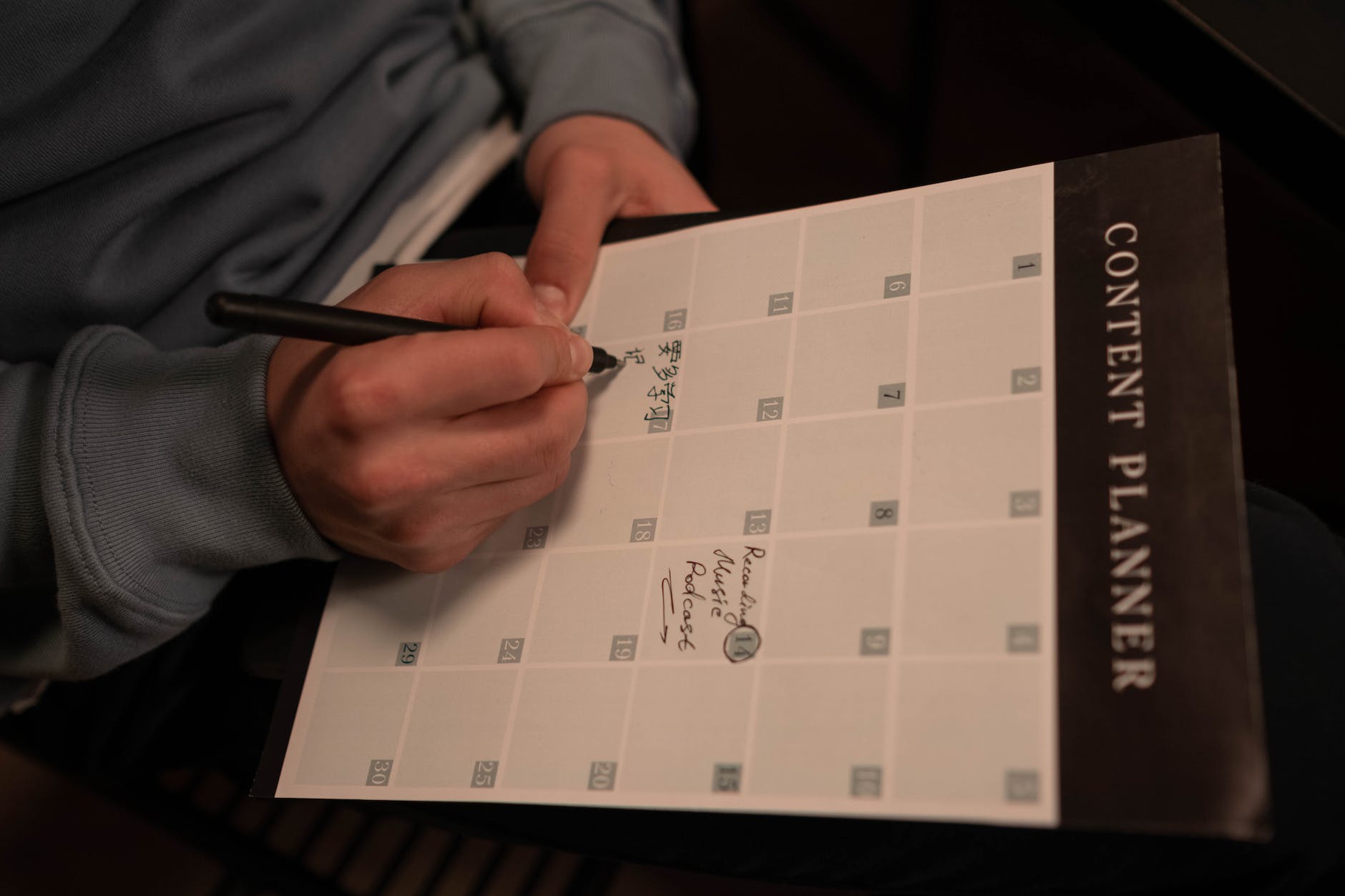For official Bullet Journal 101 instructions and to view the tutorial, visit the Bullet Journal website.

Before we begin Bullet Journal 101, a note about Notebooks:
There are so many notebooks to use for bullet journaling. Virtually any notebook will do. But the A5 Leuchtturm1917 planner with dot grid pages is the industry standard for bullet journals. However, the Moleskine Professional Notebook is just as good, especially if you’re not into designing every single aspect of your journal by hand.
Each one of these notebooks will run you about $20. But the price is right for the features:
- Built-in index
- Numbered pages
- Dot Grid Pages
- Ribbon bookmarks
- Elastic closing strap (doubles as a pen loop!)
- Durable hard cover
- Thick no-bleed pages
- Mini pocket folder.
It’s really up to you. The goal is to create a bullet journal you love. You could use a dollar store composition notebook if you want. The thing to remember about bullet journaling is you have to enjoy the process. You want to look forward to using your new notebook. So invest wisely by choosing a notebook you really love.
Bullet Journal 101 – Six Easy Steps
Step One: Create Your Index
(Pro Tip– Purchase a notebook that already comes with an index and numbered pages.)


An index is pretty self-explanatory. But if you’re confused, it’s a log or record of where everything is located within your bullet journal. You don’t need to record everything here, just the critical elements.
Your index should provide easy reference to all of the important things you want to track.
Note: It’s ok if you don’t want to buy a notebook with an index and numbered pages. You’ll just need to create the index and number the pages yourself. See the example above.
Step Two: Create a Key

Your key should be located on the page directly following your index. You can also keep it at the front or back of your journal. You’ll want it in a spot that’s easy to reference. For general bullet journaling, the key is used to differentiate tasks from events, from notes.
However, to create a Writer’s Bullet Journal take it a step further. To do this, make your key a group of symbols, colors, and letters you use throughout your bullet journal to keep track of ideas.
Examples:
- A Novel Bullet Journal might have a page full of random notes with one idea for characters and one for world building.
- A Blogging Bullet Journal might have a page full of random notes with one idea for a post and another about research.
Simply add the symbol next to each idea so when you’re flipping through later, they’re easy to spot. (See also, Collection Pages for another way to help you organize your ideas.)
Step Three: Future Log / Year-at-a-Glance
A future log is a tool for long-term planning. This is where you record tasks, events, and notes you’ll focus on throughout the year. The future log is usually located on the page next to (or right after) your key. It’s dated, with several blank lines or even a full blank page for each month. You might want to keep your future log un-dated. It’s all about what works for you and your project planning.
Here’s one of my future logs:

Examples of what to include in your future log:
- The theme of the month
- Book club picks
- Newsletter features
- An inspirational quote that goes with your theme
- Major projects and dealines
- Notes and ideas for larger projects
- Holidays, birthdays, and other major events
Record as much or as little information here as you think you’ll need. Many people keep planning information in their collection pages and monthly logs. Others use half a page for each month in their future log. The best part of a bullet journal is its versatility. Craft yours in a way that’s simple and useful for your purposes.
Step Four: Monthly Logs

The monthly log is a great way to do medium-term planning. You can use it to sketch out everything you want to accomplish over a four-week span.
Monthly Log Set Up Process:
- Start the first month after your collection pages (see Step Six).
- Use a two-page spread:
- Left Side- All the days of the month with important events & tasks listed. Leave space to add symbols from your key as needed.
- Right Side- A categorized breakdown of everything you want to accomplish that month.
- Record your daily tasks on the pages that follow.
- When each month is finished, create the following month’s log on the next available two page spread.
- Check out this amazing idea from Tiny Ray of Sunshine to use a quarterly assessment.
- The image below demonstrates how to create a quarterly review collection:
- Left Side- Everything you want to do in the next 90 days
- Right Side- Everything you actually did over those 90 days, with lots of praise and gratitude thrown in.

Step Five: Daily Logs
Daily log pages are the nuts and bolts of your Bullet Journal. They are for all of your short-term plans and goals. Start this log right after your monthly spread. Begin with the first day of the month (or the first day you happen to start your bullet journal).

This is where you record:
- Tasks you want to accomplish that day.
- Appointments or events that will occur.
- Any notes or ideas you have throughout the day.
- It can also serve as a journal, a place to draw sketches, or even a space to run through a jumbled idea.
Your daily log is where you will use your key to differentiate the day’s tasks, notes, events, and ideas. Another great feature to love about the Bullet Journal method (vs. a regular day planner) is when you inevitably miss a day.
With a bullet journal, you won’t have a blank space reminding you of missing that day. Just write down the next day and move on. The Bullet Journal method is completely customizable. So you get to craft your notebook exactly how you want it to be.
Note: A lot of people like to do weekly spreads, and then follow those with daily logs. I find this to be too much work. But if you’re a super Type-A person who wants to organize all the things, check out this post from Tiny Ray of Sunshine for some ideas on weekly layouts.
Step Six: Collection Pages
Bullet Journal 101 wouldn’t be complete without going over collection pages. They’re perhaps the absolute best thing about bullet journaling. Collections pages are everything. You can get really creative with them. So creative, in fact, there are thousands of different blog posts solely dedicated to collection page ideas. Check out some of my collection page ideas here:
- Writer’s Notebook: Powerful Tools You Need to Try ~ InkWell Spills
- Collection Page Ideas for an Awesome Writer’s Notebook ~ InkWell Spills
- Bullet Journal Spreads: Conquering Imposter Syndrome ~ InkWell Spills
- Self Care Collection Page Ideas ~ InkWell Spills
- Writer’s Notebook Ideas for A Successful Year ~ InkWell Spills
It’s a struggle deciding just how much room to leave for collection pages. A good practice is to leave a solid twenty pages. It may seem like a ridiculous amount of blank space. But trust me, you’ll need it. You’ll probably need more than that as you level up your bullet journal skills. For now, start with twenty pages and see how that goes.
What is a collection page?
A Collection Page is pretty much what it sounds like- a collection of ideas, tasks, notes, inspiration, or literally anything. A common place to put these is right after your future log. Like everything with bullet journaling, you can put yours wherever you want.
Collection pages are where your index comes in handy. You’ll use your index to record what is on each collection page and exactly where to find each one in your bullet journal. This makes finding the information you actually need simple.
You can also use a technique called threading* to refer your daily/weekly/monthly notes back to your collection pages. Or to connect collections that are spread across your journal. Basically, you write the page number you want to reference next to the ideas you’re connecting.
Threading Example:
- Page 17: notes about Character XYZ | 109
- The “| 109” let’s you know there’s more info on that page.
- Page 109: more notes about Character XYZ
- Collection Page: Character XYZ| 17, 109
- The “| 17, 109” let’s you know there’s more info on these pages.
- * Click here for a much better (and prettier) explanation from Tiny Ray of Sunshine.
Samples of Collection Pages:




- Use your collection pages to make your bullet journal unique.
- Pick what you like, forget what you don’t.
- Try something new and see if it works for you!
Pro Tip: It’s a good idea to decide on what your collection pages will be before you set up your journal. This way you know exactly how much space you will need to leave for them.

Before you leave, a few quick notes:
- Don’t be too concerned about mistakes. Especially if this is your first attempt.
- Tiny Ray of Sunshine and other professional bullet journalers are just that: professionals. This is their art and their work.
- Your bullet journal should be a functional tool that helps you keep your life organized.
- Focusing too much on how it looks might stress you out. This could make using your journal a chore rather than a fun way to organize your life.
- Migrating: Is a process where you use an arrow to show yourself that you need to move something.
- A right facing arrow indicates moving something forward in your Bullet Journal.
- A left facing arrow moves it back to a collection page or future log.
- Finally, don’t get too focused on making your bullet journal look like someone else’s.
- I encourage you to browse the internet for ideas.
- But only to help you focus yours.
- You can’t include everything in a bullet journal. And it won’t help you if you do.
- Use what’s helpful, forget the rest, or save it for next time.
Don’t forget to drop the InkWell Spills Pinterest Page for tons of Bullet Journal Ideas:

I hope you enjoyed reading my Bullet Journal 101 crash course. Hopefully, it has been helpful and not confusing. It would be great to get some feedback on this article to let me know if I need to clarify, shorten, or even remove some things. So please, comment away!
Best of luck on your bullet journal journey!

Note: In this Bullet Journal 101 course, I have briefly covered some ideas on using a bullet journal for writing projects. Visit my guide on How to Create a Writer’s Notebook Using the Bullet Journal Method, which covers everything you need to create a writer’s bullet journal in more detail.
Up Next, Supplies List – all the tools you need to create a beautiful bullet journal.
Note: This page may contain affiliate links for which, if an item is purchased, I will receive a small commission at absolutely no extra cost to you. I only ever post links for products that I have used, found helpful, and loved. Thank you for supporting my writing journey so I can continue to help you on yours!




